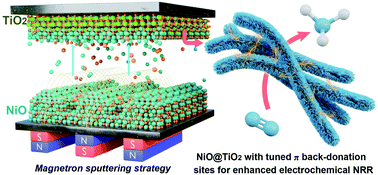Magnetron sputtering tuned “π back-donation” sites over metal oxides for enhanced electrocatalytic nitrogen reduction†
Abstract
As an environmentally-benign and sustainable option for NH3 synthesis, the electrochemical nitrogen reduction reaction (NRR) is expected to replace the traditional Haber–Bosch process. Transition metals with empty d-orbitals achieve NRR activity via a “π back-donation” process. However, the problem in overcoming hydrogen evolution reaction (HER) competition makes the exploration of transition metal-based catalysts with relatively inferior HER activity worthwhile. The challenges lie in designing a rational structure for efficient NRR. Herein, Ni3+ and oxygen vacancies were synergistically integrated on NiO@TiO2 by magnetron sputtering, which provide this transition-metal oxide-based (TMO-based) material with “π back-donation” behavior. Accordingly, NiO@TiO2 exhibited NH3 yield (∼10.75 μg h−1 cmcat.−2) and faradaic efficiency (∼9.83%), which are nearly 10-fold higher relative to those of TiO2 in neutral media. This work provides an efficient strategy for engineering “π back-donation” sites, and holds great potential in exploring new TMO-based electrocatalysts.

- This article is part of the themed collection: Journal of Materials Chemistry A HOT Papers


 Please wait while we load your content...
Please wait while we load your content...